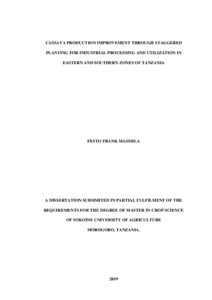| dc.contributor.author | Masisila, F.F. |
| dc.date.accessioned | 2022-10-25T15:40:48Z |
| dc.date.available | 2022-10-25T15:40:48Z |
| dc.date.issued | 2019 |
| dc.identifier.citation | Masisila, F.F. (2019). Cassava production improvement through staggered planting for industrial processing and utilization in eastern and southern zones of Tanzania. Morogoro, Tanzania: Sokoine University of Agriculture, (134p.). |
| dc.identifier.uri | https://hdl.handle.net/20.500.12478/7906 |
| dc.description.abstract | An experiment was conducted with the aim of identifying suitable cassava scheduled planting, harvesting and varietal performance in order to optimize growth, development, yield and quality of cassava during the 2017/18 - 2018/19 cropping season. The experiment was conducted at Naliendele, Nachingwea and Ilonga TARI Research Centres in Tanzania. The experiment was laid out as split-split plot in a randomized complete block design with variety being main factor, harvesting time as sub plot and planting schedules as sub-sub plot with four replications at each site.Factor A with three levels which were Kiroba, Mkuranga 1 and Chereko variety. The sub plot also with three levels that were harvesting at eight, ten and 12 months after planting while factor C also with three levels of planting times in November/December, January and March/April. The total root yield increased significantly from first to third planting and harvesting times respectively. Kiroba variety planted in November/December and then harvested at twelve months after planting (MAP) gave highest total fresh root yield 27 tones per hactre (t/ha) in the Southern zone followed by Eastern zone with Kiroba variety planted in November/December and March/April yielded highest total root (22t/ha) when harvested at 12MAP. Based on cassava dry matter content; the study shows that: highest dry matter content was obtained when Mkuranga 1 variety planted in November/December and harvested at 12MAP gave 40% followed by Kiroba variety planted in November/December and harvested after 12MAP had 39% in Southern zone. Also the study found that; cassava starch content was highest (23%) in Southern zone when Mkuranga 1 variety planted during November/December and harvested at 12MAP before the onset of rainfall. The current results recommend that practising planting cassava in November/December for fresh cassava utilization and adopt the late planting in March/April can be advantageous in small scale and commercial producers. |
| dc.description.sponsorship | Bill and Melinda Gates foundation |
| dc.format.extent | 134p. |
| dc.language.iso | en |
| dc.publisher | Sokoine University of Agriculture |
| dc.subject | Cassava |
| dc.subject | Harvesting |
| dc.subject | Planting Date |
| dc.subject | Starch |
| dc.subject | Yields |
| dc.subject | Soil |
| dc.subject | Nutrition |
| dc.subject | Necrosis |
| dc.subject | Genotypes |
| dc.subject | Growth |
| dc.subject | Agronomy |
| dc.title | Cassava production improvement through staggered planting for industrial processing and utilization in eastern and southern zones of Tanzania |
| dc.type | Thesis |
| cg.contributor.affiliation | Sokoine University of Agriculture |
| cg.contributor.affiliation | International Institute of Tropical Agriculture |
| cg.coverage.region | Africa |
| cg.coverage.region | East Africa |
| cg.coverage.country | Tanzania |
| cg.coverage.hub | Eastern Africa Hub |
| cg.identifier.bibtexciteid | MASISILA:2019 |
| cg.authorship.types | CGIAR and developing country institute |
| cg.iitasubject | Agronomy |
| cg.iitasubject | Cassava |
| cg.iitasubject | Food Security |
| cg.iitasubject | Genetic Improvement |
| cg.iitasubject | Livelihoods |
| cg.iitasubject | Nutrition |
| cg.iitasubject | Plant Breeding |
| cg.iitasubject | Plant Production |
| cg.iitasubject | Post-Harvesting Technology |
| cg.iitasubject | Soil Fertility |
| cg.iitasubject | Tissue Culture |
| cg.iitasubject | Value Chains |
| cg.notes | IITA supervisor: Dr. Pypers, P.
IITA supervisor: Dr. Nzokwe, V.N.E. |
| cg.publicationplace | Morogoro, Tanzania |
| cg.accessibilitystatus | Limited Access |
| cg.reviewstatus | Peer Review |
| cg.usagerightslicense | Copyrighted; all rights reserved |
| cg.targetaudience | Scientists |
| cg.futureupdate.required | No |
| cg.contributor.acknowledgements | Glory be to God The Almighty who strengthened and enabled me to finish this study. This work would not have been possible without the financial support of African Cassava Agronomy Initiatives Project scholarship through IITA East African Hub under Bill and Melinda Gates foundation. I am especially indebted to Dr. Geoffrey Mkamilo, The General Director of Tanzania Agricultural Research Institute (TARI) who have been supportive of my career goals and who worked actively to provide me with the protected academic time to pursue those goals. I am grateful to all of those with whom I have had the pleasure to work with during this and other related projects like Drs; Pieter Pypers, Deusdedit Peter Mlay, Veronica NE Uzokwe and Bernadetha Kimata. The staff at TARI Naliendele especially Root and Tuber Research Program (Rahim Menya, Dwasi Gambo, Zawadi Kilingala, Zamira Matumbo, Joel Pwelle, Julius Hassan, Eliutha Gama, Abdul Muhsin, Filemon Shagihilu and Mahamud Rajabu), TARI Ilonga, Mkumba experimental station at Nachingwea-Lindi region especially Mashaka Kusaya and Mchele Bukelebe, IITA staff at Dar es Salaam, Sokoine University of Agriculture (SUA) staff and my MSc. Classmates 2016/2017 intake. Each of the members of my dissertation committee has provided me extensive personal and professional guidance and taught me a great deal about both scientific research and life in general. I would especially like to thank Prof. Cornel L. Rweyemamu, as my supervisor and mentor; he has taught me more than I could ever give him credit for here. He has shown me, by his example, what a good scientist (and person) should be. Nobody has been more important to me in the pursuit of this study than the members of my family. I would like to thank my parents both biological and spiritual, whose love and guidance are with me in whatever I pursue. They are the ultimate role models. Most importantly, I wish to thank my loving and supportive wife, Nurse Josephine J. Lukindo, and my two wonderful sons, Cornelius and Ian who provide unending inspiration. |

